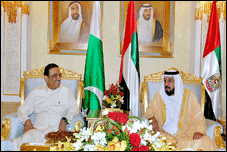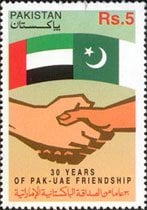Mehmood-Ul-Hassan Khan
Pakistan and the United Arab Emirates enjoy privileged relations at all political, economic and social levels. The strong foundation of such relations that are based on deep-rooted cultural affinities, common faith and trust was laid by late Sheikh Zayed bin Sultan Al Nahyan over the past four decades. It continues to be patronized by H.H. Sheikh Khalifa Bin Zayed Al Nahyan, the President of the UAE and H.H. Sheikh Mohammed bin Rashid al Maktoum, Vice-President, Prime Minister and Ruler of Dubai. On its part, Pakistan has always valued its relations with UAE and looked forward for wider cooperation in various fields.
Pakistan was the first country to accord formal recognition to the establishment of the Federation of seven Emirates in 1971. Bilateral relations have progressed steadily ever since. More than 1.2 million Pakistani expatriates are working in UAE. Their earning contributes substantially to the foreign reserves of Pakistan. The ongoing consultations between the leadership of both countries and frequent exchanges of delegations at all levels reflect the time-tested relations.
UAE‘s institutional role in friends of Democratic Pakistan Forum
Through the initiative of the United states of American and the United Arab Emirates, the Friends of Pakistan Forum , named later Friends of Democratic Pakistan (FoDP) was launched at New York in September 2008 and joined by 22 countries including Saudi Arabia, Australia, Britain, Canada, China, France, Germany, Italy, Japan, Turkey, United States, United Nations and European Union. Three Ministerial Meetings have been held in Abu Dhabi, Tokyo and Istanbul, and a Summit Meeting in New York last year. Next Ministerial Meeting will be held in Brussels on October 15, 2010. It stands as an important forum to complement Pakistan’s efforts and strategies towards socio-economic development:
(a) Easy and free market access to the USA and the EU markets
(b) Capacity building of civilian institutions especially health, education, infrastructure
(c) Investment in education and social sector for changing the mindset
(d) Speedy delivery of equipment to fight insurgency.
(e) Long-term partnership on the basis of shared core values
(f) Poverty alleviation programme
Right from its inception, the government of the UAE has been extending its moral, political, institutional and financial support. Early, this year the Friends of Democratic Pakistan (FoDP), Public-Private Conference was held in Dubai on January 26. Addressing the conference, the Foreign Minister of UAE Sheikh Abdullah bin Zayed Al Nahyan reaffirmed his country’s commitments towards the development of Pakistan.
A meeting of Senior officials (FoDP) was held in November 2008 , experts meeting in April 2009 , Tokyo donor conference in which UAE pledged $ 300 million and recently the Islamabad meeting last July attended by representatives of 12 countries. Ambassador Ali Mohammed Al Shamsi, UAE special envoy to Afghanistan and Pakistan stated that the Government of UAE is taking concrete steps to help Pakistan to overcome its macro-economic difficulties.
UAE assistance to Pakistan
According to the UAE Foreign Aid Report (2009), the UAE government and Emirati donor organisations gave about Dh 9 billion (US$2.45bn ) in foreign aid in 2009. Yemen and Pakistan were the two biggest recipients of UAE foreign aid. Both the countries received Dh2.2bn and AED 1.60 billion respectively.
The aid to Pakistan was allocated for internally displaced people of Swat valley, Malakand and other districts of Khyber Pakhtunkhwa and South Waziristan in the tribal belt. In total, Pakistan received commitments of AED 1.60 billion ($436.7 million) from UAE donors. The UAE committed grants of worth AED 998.5 million ($270 million) through Abu Dhabi Fund for Development in response to the submission of project proposal by the Government of Pakistan. Health was the main sector to receive AED 349.9 million. The report reveals that AED 183.1 million was spent on humanitarian assistance, almost third of the total aid.
Khalifa Bin Zayed Al Nahyan Humanitarian Foundation made generous contributions in response to the immediate needs of the displaced people from the hostilities region. Further contribution was delivered to the United Nations High Commissioner for Refugees (UNHCR) worth more than AED 55.1 million for distribution. Moreover, the UAE government contributed a further AED 590.6 million more than two thirds of which AED 359.1 million was directed towards health projects. The UAE Red Crescent Authority also contributed more than AED 20.5 million.
The following table shows the amounts given by the different UAE donors to Pakistan during 2009
Donors Amount (million AED)
Khalifa Bin Zayed Al Nahyan Humanitarian Foundation 71.7
Al Maktoum Charitable Foundation 0.61
Zayed Bin Sultan Al-Nahyan Charitable and Humanitarian Foundation 2.9
UAE Red Crescent Authority 20.5
Government 509.6
Sharjah society 0.07
Source: The government of UAE (July, 2010)
Humanitarian Assistance
Soon after the news of the worst ever floods that hit all the provinces of Pakistan and destroyed the socio-economic fabric and the appeal of the Prime Minister of Pakistan Sayed Yousuf Raza Gillani, His Highness Sheikh Khalifa bin Zayed Al Nahyan, the President of UAE ordered urgent delivery of relief goods to shelter the displaced people. In compliance with his directives, the Khalifa Bin Zayed Al Nahyan Foundation has already started its humanitarian operations in Pakistan and has so far distributed 6000 tents, 13,000 bags of wheat flour, 3000 bags of lentil, and 15000 food packages and provided needed medicines and medical emergency kits. The distribution will cover the people of most devastated areas that include Swat, Peshawar, Nowshera and Ranjanpur and cities in Sindh. Sheikh Zayed bin Sultan Al Nahyan humanitarian Foundation has sent military helicopters carrying relief goods to floods affectees. A delegation from UAE Red Crescent is supervising the purchase and distribution of food and other commodities.
Social Welfare Projects
His Highness Sheikh Khalifa bin Zayed Al Nahyan, the President of UAE initiated many mega welfare projects throughout Pakistan in pursuit of the foundation laid down by the Founder of the modern state of UAE late Sheikh Zayed bin Sultan Al Nahyan . Khalifa Bin Zayed al-Nahyan humanitarian Foundation, Zayed Charitable, Humanitarian Foundation, Mohammaed bin Rashid Charitable Foundation and Red Crescent have sponsored many social welfare projects in Pakistan. So far, more than 200 projects including hospitals, healthcare units, dispensaries, colleges, schools, , housing units, an airport, bridges, roads, water supply system for human consumption and irrigation of plants and pastures in arid lands have been completed. These projects have become centers of hope.
Strengthening of bilateral trade & commerce relations
The leaders of both the countries are committed for further strengthening of bilateral trade and commerce ties. In this regard, the 9th Pak-UAE Joint Ministerial Commission was held in 2007. Agreements on bilateral political consultations, establishment of Joint Business Council and protocols on cooperation in culture /media were signed.
Trade Volumes
The UAE is Pakistan’s second largest global trading partner and it is also the second largest source of home remittances from Pakistani expatriates.
Imports-Exports
($ million)
Year/ Period Import Exports
1999-2000 907,588 492,710
2000-01 1,336,902 625,905
2001-02 1,353,940 727,474
2002-03 1,509,635 1,039,168
Change % 42.5 11.50
2003-04 942,913 1,708,688
Change % 13.19 9.26
2004-05 1,095,485 1,703,131
Change % 16.18 10.33
2005-06 3,405,563 1,312,757
Change % 19.83 99.96
2006-07 2,769,091 1,385,082
Change % 5.51 18.69
2007-08 3,413,527 2,070,953
Change % 49.52 23.27
2008-09 3,159,742 1,469,990
Change % 29.02 43
Source: State Bank of Pakistan & Board of Investment
The comparative study of the above table shows that the trade volumes are greatly in favour of UAE. Concrete efforts, frequent visits and exchange of business communities, sharing of information/data, and collaboration would be useful to increase the trade volumes. According to BOI figures the UAE investments in Pakistan may be increased.
Imports-exports commodities
According to the Federation of Pakistan Chambers of Commerce and Industry (FPCCI), the increase in overall exports from Pakistan has come primarily from non-traditional exports items accounting for 67 percent of the increase followed by 35 percent from textile manufacturers and four percent from other manufacturers.
Country Exports to Pakistan
UAE Petroleum, petrochemical products, iron ore, scrap-plastics, chemical products, non-ferrous metals-machines, spare parts of cars ships and boats
Imports from UAE
Nylon textiles, silk & wool, rice, cotton, crochet-dye, textile-treatment requirements of fabrics and clothes, towels, marble and surgical instruments
Source: FPCCI (August, 2010)
Foreign Direct Investments
According to the data of SBP and BOI, the UAE is also one of the biggest investor in Pakistan. Pakistan has tremendous opportunities for investment in the core infrastructure development; electricity generation, or water desalination, technology for agricultural sector.
The comparative statistical analysis, shows that inflows of FDIs is going higher and higher with the passage of every year. It was $228.6 million in 2008-2009 which reached to $248.6 million in the fiscal year 2009-2010. The portion of private sector’s investment is on the decline which needs to be revised. Respective chambers of commerce, Pak-UAE Business Council and person-to-person contact could be useful to boost further the trade volumes.
($ million)
2009-2010 (July-June)
Country Direct Private Public Total
UAE 243.1 5.5 – 248.6
2008-2009(July-June)
Country Direct Private Public Total
UAE 178.1 49.9 – 228.0
Source: SBP
The year-wise comparison indicates that pace and scope of UAE’s FDIs is on the rise which should be tapped for the stability and sustainability of Pakistan’s macro-economy. More business, people and investment’s friendly policies would be instrumental to achieve greater inflows of FDIs from UAE.
($ million)
Year/Period Amount
2000-01 5.2
2001-02 21.5
2002-03 119.7
2003-04 134.6
2004-05 367.5
2005-06 1,424.5
2006-07 661.5
2007-08 589.2
2008-09 178.1
2009-2010 243.1
Source: SBP & BOI
Country Preferred Areas of investments
UAE Energy, construction, telecommunication, oil & gas exploration, insurance, banking, aviation, food packaging, hotels and agricultural equipment
According to the latest figures of the BOI, the total investment so far has reached $20 billion dollars. The Government of Pakistan has invited UAE’s public and private sectors to invest in energy sector, airline and infrastructure. Investments in agriculture, agro-based industries and hydro-power generation may also be beneficial to both the countries.
UAE Private Companies in Pakistan
The following table indicates that many big private companies of UAE are working in Pakistan and contributing good things in many sectors of the macro-economy.
Sectors Names of the companies
Telecommunication Etisalat, Warid, Wateen and U-phone
Banking Bank Al Falah under Abu Dhabi Group, Dubai Islamic Bank, Emirates Global Islamic Bank
Real Estate Emaar Properties Group, Al-Ghurair Giga and Al Habtour Trading Enterprises, Bahria Emirates, DAMAC and Al-Ghuran
Airlines Etihad Airways , Emirates Airlines and FlyDubai
Insurance Al-Falah Insurance Company, Emirates Investments Group, which owns Emirates Global Islamic Bank have plans to invest in the insurance sector namely Takaful Pakistan Limited and in the real estate project of Karachi Financial Towers.
Joint Ventures
The Minister of Privatization Waqar Ahmed Khan, who held investment portfolio, stressed the need to have Joint ventures in petroleum and petroleum products, aluminum products, agriculture (horticulture, corporate agricultural farming, dairy farming and livestock), financial sector, housing (prefabricated houses and affordable low income houses) and power. In an interview with Emirates News agency, he said that joint ventures facilitate qualitative and quantitative inputs in the macro-economy. It generates job opportunities and also supportive in industrial production.
Conclusion
Economists and experts of international marketing are of the opinion that regular meetings on joint ministerial commission and rigorous follow-up of the signed MOUs and agreements between the two countries may bring dividend for both the countries. In order to increase the bilateral trade volumes and other related business activities, effective role of Pak-UAE Business Council, frequent visits of respective chambers of commerce, holding of exhibitions and expos, sharing of information among the business community and potential investors must be speeded-up. Extension of coordination and collaboration in science and technology fields is required to be streamlined. The two countries can consider cooperation in the fields of education, alternative energy resources i.e. solar, wind, and geothermal, alternative/renewable energy resources i.e. solar, wind, geothermal, food security, dairy development and agro-based industries.




Respected Sir give a chance to serve BS(HONS) Economics and Finance